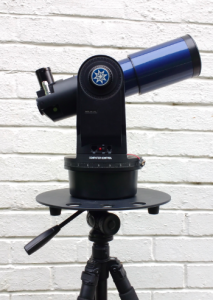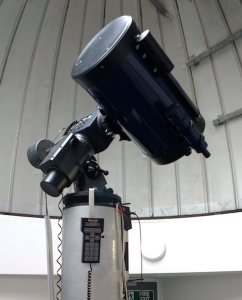Teaching
Astronomy is an observational science. Ultimately all information we gain about the Universe stems from photons that are collected by telescopes. Therefore, observations are a core part of astronomy teaching. We train astronomy students from first year onwards in the use of telescopes. With every year, students gain experience and get to use larger and more powerful telescopes. This is the St Andrews telescope hierarchy:
Our smallest telescope – a Meade ETX80, an achromat refractor with 8cm lens. This may look like a toy, but it is a computerized toy with great optics and very compact size. Galileo would have killed for a telescope like that. In addition to two of these, we also have an antique brass refractor of similar size. These scopes turns the Moon into a landscape and Jupiter to an alien world. They are available for students from 1st year onwards.
Step 2
This is the Meade 10″ telescope, one of the two permanently installed telescopes in the Napier building. It’s one of many telescopes with Schmidt-Cassegrain optics at the observatory, we also have a 16″ and two 8″. Our Meade 10″ and 16″ are about 20 years old, but true workhorse telescopes – convenient, robust, and versatile. They can be used with an eyepiece, with standard digital cameras, or with CCDs. From 2nd year onwards, students can learn how to use them.
Step 3
The James Gregory Telescope is the 2nd Schmidt-Cassegrain ever built and to this day the largest of its kind in the world. Today the JGT is mostly a training telescope that does research. The JGT is unique, a big research grade telescope on campus, just 10 minutes walk away from town. Astronomy students in St Andrews will meet the JGT in their first weeks at the university. The telescope is also featured in lots of science and non-science courses around the university. In 4th year, the JGT provides data and observing experience for honours astro students in a course called Observational Astrophysics. Every year we offer final year projects for undergraduate students that include observing with the JGT. The JGT is part of our postgraduate observing training, that also includes lectures and an observing run at Teide Observatory in Tenerife.


